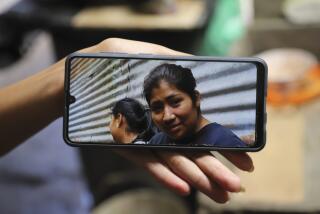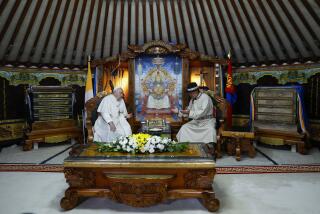For Children in Mongolia, a Life on the Streets
- Share via
ULAN BATOR, Mongolia — He’s 15, but after a childhood with too little to eat, he looks no older than 10.
Born the year that Mongolia became a democracy after decades of communist dictatorship, Erdenebat lives on the crumbling streets of the capital, scrounging in garbage cans for rotting vegetables and clumps of moldy rice that he shoves into his mouth with grimy hands.
“I left home because there was no food to eat,” he says.
A decade of economic decline has left thousands of Mongolian children homeless, and their ranks are growing steadily. Activists worry that with no recovery in sight, the country is abandoning a generation of youngsters to life in the street.
“Is there light at the end of the tunnel? I don’t know,” says Father Gilbert Sales, director of the Verbist Care Center, which gives 120 street children a place to live and enrolls them in school.
The end of communist rule in 1990 was peaceful, but Soviet subsidies that once accounted for one-third of Mongolia’s economy ended overnight. Herders lost their monthly wages. Factories closed and the economy collapsed.
Thousands of rural families drift into Ulan Bator each year looking for work, adding to the city’s homeless population.
In winter, when temperatures in Ulan Bator fall to minus 22 degrees, people shelter in manholes whose heavy covers are gone, stolen for sale as scrap metal.
“Every Wednesday, we go to the street and visit the manholes looking for new street children,” says Sales, whose center is run by the Roman Catholic charity Caritas. “It’s now the second or third generation in the same vicious cycle.”
There are an estimated 4,000 street children in Mongolia -- a huge number in a country with just 2.5 million people.
Many live on the streets full time and don’t know where their parents are.
At the Lotus Children’s Center, another home for street children, 16-year-old Batstesteg Soninbayar worries about the future.
His favorite subject at school is English, which he speaks almost fluently. But he wonders whether his education will be enough to keep him off the streets.
“Mongolia is not getting better,” Soninbayar says.
“There are not enough jobs. Even when university students graduate, they have certificates, but there’s not so much work for students.”
He is too young to remember communism, but he has heard it was a time when everyone had a job and enough to eat.
“Communism was better, because when there was communism everybody could study,” he says.
Mongolia’s poverty has fed nostalgia for communism, to the chagrin of democracy supporters who took to the streets in 1990 to bring down one-party rule.
The presidential election in May was won by the candidate of the formerly communist Mongolian People’s Revolutionary Party, Nambariin Enkhbayar, who said one priority would be to attract investment in the country’s rich gold and copper mines.
“Creating jobs is the only way to fight poverty and corruption,” he said in an interview.
There are success stories.
Baatryn Bolortsetseg was 13 and living under the stairwell at her school when teachers noticed her grades slipping and sent her to the Verbist Care Center. Now 21, she has finished college with a nursing degree and is returning to the center to work as a nurse.
“Since I was a child, I always wanted to become a medical professional,” Bolortsetseg says.
“She’s a very intelligent girl,” Sales says, beaming.
Didi Ananda Kalika, an Australian who runs the Lotus Children’s Center, recalls a girl who grew up in her center, left and got pregnant, then dropped her baby off to be reared there. “I’m not too happy about that,” Didi says.
Didi -- a yogic nun, formerly Gabrielle Dowling -- arrived in Mongolia in 1993 to work as a teacher and started sheltering homeless teenage girls to protect them from sexual predators.
Soon, police stations and hospitals began calling her to take in abandoned babies. Didi and the staff of her center in an Ulan Bator slum were “a bit scared,” she said. But now her light-filled children’s center teems with rambunctious toddlers in donated clothes.
Some parents say they plan to retrieve their babies once they find work.
“Some of them, we don’t know if they’ll be back,” Didi says.
More to Read
Sign up for Essential California
The most important California stories and recommendations in your inbox every morning.
You may occasionally receive promotional content from the Los Angeles Times.













